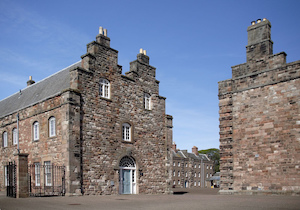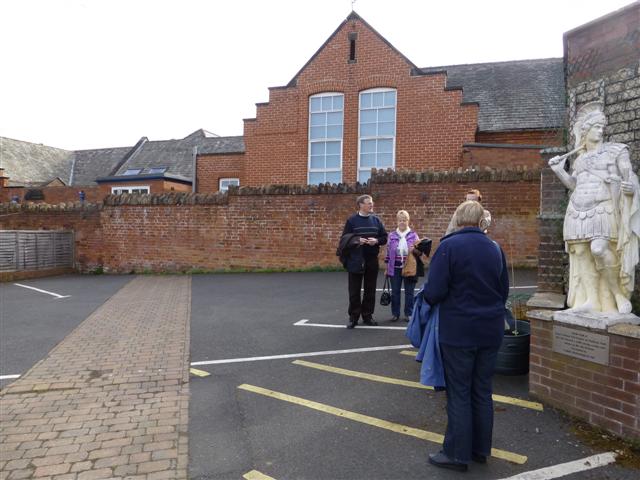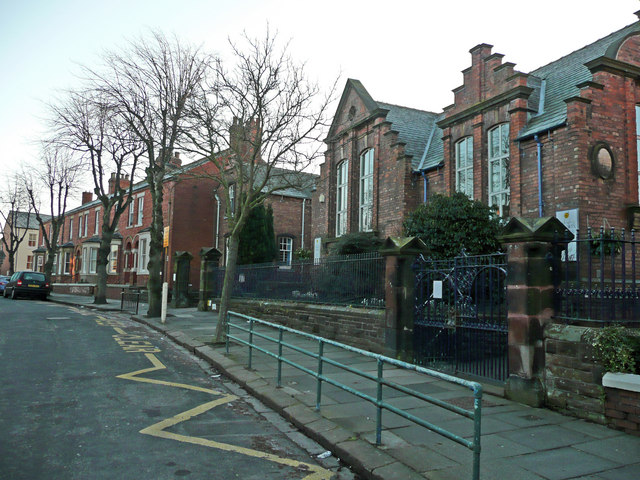Topics > Northumberland > Berwick upon Tweed > Berwick-upon-Tweed, 1855 > Churches and Public Buildings of Berwick, 1855
Churches and Public Buildings of Berwick, 1855
Extract from: History, Topography, and Directory of Northumberland...Whellan, William, & Co, 1855.
CHURCHES, CHAPELS, PUBLIC BUILDINGS. etc.
HOLY TRINITY CHURCH was erected in 1648, under the direction of Colonel George Fenwick, of Brinkburn. The materials employed in its construction were the stones composing the outside walls of the old castle of Berwick, and it occupies the site of the ancient church, which was pulled down during the reign of Queen Mary. The present edifice is of no particular order of architecture, the second storey being supported on pillars, joined together by arches, and not springing from the walls of the first storey. It has the appearance of one church standing on the roof of another, and as it possesses neither tower nor bells, the congregation is summoned by the bells of the Town Hall. The interior is very handsome, having several beautiful monuments, an excellent organ, and a very fine altar piece. The parish register commences in 1572. The living, a vicarage in the archdeaconry of Lindisfarne and deanery of Norham, is rated in the Liber Regis at £20; annual value, £289. The patronage is vested in the Dean and Chapter of Durham. Rev. George Hans Hamilton, M.A., vicar; Rev. Thomas Proctor, B.A., curate.
OUR BLESSED LADY AND ST. CUTHBERT's CATHOLIC CHURCH is situated at Ravensdowne, and is a very neat stone edifice, capable of accommodating about 300 persons. Rev. Anthony Mc.Dermott, priest.
THE INDEPENDENT CHAPEL, Castlegate, is a large commodious stone building, erected in 1848, at a cost of £1,200, and will accommodate about 700 hearers. Rev. George C. Morrison, A.M., minister. THE SCOTCH CHURCH, or High Presbyterian Meeting House, High-street, was erected in 1724, and possesses sufficient accommodation for I,500 persons. Rev. James A. Miller, minister. THE LOW PRESBYTERIAN MEETING HOUSE is situated on the east side of Hide Hill. It was erected by subscription in 1719, and will seat about 700 persons. Rev. William Gray, minister. In 1729, Joseph Watson, Esq., bequeathed £5 per annum to the ministers of each of the two last-mentioned places of worship, and also £10 to be distributed yearly to ten of the most deserving poor widows of both congregations. THE SECESSION CHURCH, Golden-square, was built by the Scotch Burghers, in 1770, and enlarged in 1796. It will now accommodate about 1,200 hearers. Rev. John Cairns, minister. THE UNITED PRESBYTERIAN CHAPEL, Church-street, was erected by the Anti-Burghers, in 1812, and will seat about 500 persons. Rev. Robert Peden, minister. THE UNITED PRESBYTERIAN CHAPEL, Chapel-street, was built in 1756, and will accommodate 900 worshippers. Rev. William Ritchie, minister. THE WESLEYAN METHODIST CHAPEL, Walkergate-lane. Rev. Robert Totherick, minister. THE PRIMITIVE METHODIST CHAPEL, College-place, was erected by subscription, in 1829, at a cost of £664. It is a neat stone edifice, and will accommodate about 500 persons. Rev. William Fulton, minister. THE BAPTIST MEETING ROOM is in Walkergate-lane, and will seat about 300 persons. Revs. Alexander Kirkwood and Charles Robson, ministers. THE ENGLISH PRESBYTERIAN CHAPEL, Bank-hill, is a neat stone building, erected in 1835, at a cost of £1,100, and possesses about 600 sittings. Rev. Alexander Murdock, minister.
THE GRAMMAR SCHOOL is situated in High-street. In this establishment the sons of the burgesses receive a first-rate classical education gratuitously. The institution is endowed with the three following bequests, viz. : one-sixth of the tithes of Cheswick, in the chapelry of Ancroft, in Northumberland, bequeathed by Robert Jackson, Esq., in 1647, and now worth £56 per annum; a school and dwelling-house for the master, left by Sir William Selby, in 1648, and one-fourth part of the estate called Cold Martin's Farm, in the parish of Chatton, in Northumberland, bequeathed by Christopher Hopper, Esq., and now producing £65 per annum. The annual income arising from lands and tithes, is about £650. The surplus remaining after paying the schoolmaster's salary, is appropriated towards the liquidation of a debt incurred in rebuilding the school and repairing the master's dwelling-house. The trustees are twelve gentlemen appointed by the Court of Chancery. Master, the Rev. T. M. Dickenson, M.A., who has a dwelling-house free of rent and taxes, and the privilege of teaching an unlimited number of non-freemen's sons, who pay a certain quarterly salary. Near to the above institution, are the CORPORATION SCHOOLS which occupy a fine and spacious edifice, on the Bank Hill. This structure was erected in 1798, and at present (1854), there are about 420 scholars receiving a gratuitous education in this establishment, to which the children of the burgesses have free access. Rev. David Brown, Alexander Slight, John Binning, and John Wright, teachers.
THE CHARITY SCHOOL, Ravensdowne, owes its origin to the humane and benevolent exertions of the late Captain Bolton, of Berwick, who, in 1725, endowed it with £800. It has since received additions to its revenues from the following sources, viz.: £50 from Percival Clennell, Esq. ; £100 from Mr. John Brown; £20 from John Bell; £5 from Mr. John Reid; £91 2s. 3d. from Robert Edmuntson, Esq.; £100 from an unknown benefactor; £1,000 in the three per cents, from Mr. Cole, a Memel merchant, but a native of Berwick; £500 from Dr. Ralph Patterson; and £100 from William Grieve, Esq. The establishment is at present attended by about 190 boys, 40 of whom are clothed and educated gratuitously, and is conducted by Mr. Michael Lister, who receives £60 per annum besides the weekly payments of the scholars. He is assisted by four pupil. teachers. This school occupies a good stone building, which was considerably enlarged in 1843, at an expense of £455. It will now accommodate 200 pupils. Thomas Hubback. Esq., treasurer.
THE SCHOOL OF INDUSTRY, Palace Green, was established in 1819, under the patronage of the ladies of Berwick, by whose annual donations it is liberally supported, for the education of poor girls, of whom there are now 100 in the school. Jane Patterson, mistress. Besides the above there are also schools attached to the different places of worship in the town, as also several private establishments for education.
BANKS. NORTHUMBERLAND AND DURHAM DISTRICT BANK, Bridge-street. Business hours, from 10 a.m. to 3 p.m. except Fridays, when the bank closes at 1 p.m. This establishment draws upon Glyn, Mills, & Co., Lombard-street, London, W. H. Logan, agent. THE UNION BANK is situated on Hide Hill. Hours of business as above. This bank draws upon the Union Bank, Prince's. street, London, and the Bank of Scotland, Edinburgh ; Andrew Mallock, agent. THE SAVINGS BANK, Quay Walls, is a provident institution which affords a safe and profitable investment for the savings of the humbler classes. It was first established here in February, 1816, and it is open on Mondays, from 6-30 to 8 p.m., William Paulin, secretary.
THE BARRACKS are situated on the east side of the town, near to the walls, and almost facing the church. They were erected in 1719. The buildings are very strong and two storeys high, composing a square of 217 feet by 121, and are calculated to accommodate upwards of 500 men. After being for many years unoccupied, the Russian war has caused them to be again brought into use, and the sound of the bugle may once more be heard summoning to their various duties, the brave defenders of our hearts and homes.
THE COUNTY COURT for the recovery of debts under £50, is held on the third Tuesday in each month, in the Town Hall, James Losh, Esq., judge; Henry Ingledew, clerk; George W. Dalton, deputy clerk; and John Currie, bailiff. Clerk's office, Silver-street.
CUSTOM HOUSE, QUAY WALLS, John Adley, Esq., collector; James H. Blair, Esq., comptroller; Jordan Evans, searcher, landing waiter, gauger, and tide surveyor; Robert Meikle, clerk; and John Brown, locker.
DISPENSARY. This, the most important benevolent institution in Berwick, was established in 1814, for the purpose of affording medical and surgical aid to the lame and sick poor. From its foundation at the above mentioned period, it has rendered invaluable services to the people of this town and neighbourhood, by whom its benefits are highly appreciated. It stood formerly in a yard, in Church-street, but a proper building having been erected on the Quay Walls, the offices, etc. were removed there. Hot and cold baths can also be obtained at a trifling cost. Expenditure for the past year, £150, James Marshall, secretary.
GAS COMPANIES. Berwick possesses two gas companies; the "Berwick· upon-Tweed Gas Light Company," and the " Berwick and Tweedmouth Gas Company." The former was founded in 1821, and the company's works situated at Fulford, were executed the same year, at an expense of £3,700, and the town was first lighted with gas on the first of January, 1822. The gasometers of this company are capable of holding 10,000 cubic feet of gas. The company supply the public at eight shillings per I ,000 cubic feet. Mr. James Paterson, secretary and manager. The works of the Berwick and Tweedmouth Gas Company are situated at Spittal. They were erected in 1844, and contain a gasometer capable of holding 20,000 cubic feet of gas, which is supplied to the public at the same rate, as by the above company: William Taylor, manager; John Wright, secretary.
MARKETS, FAIRS, etc. The Corporation of Berwick, according to their charter, have the right of holding two weekly markets on Saturday and Wednesday, but only the latter day is at present observed. The Corn Market is held on the site of the old shambles, Hide Hill, where great quantities of corn are sold by sample. The Fish Market is held in the centre of High-street, and is generally well supplied. The Fruit and Vegetable Market is also held in the same street. The Butter, egg, and Poultry Market, is held under the Town Hall. Three high markets are established in the year for the hiring of servants, sale of black cattle, horses, etc. An annual fair is also held on the last Friday in May.
MECHANICS' INSTITUTION AND NEWS ROOM. This useful institution situated in High-street, was established in 1850, and is open daily from 8 a.m. to I 0 p.m., Sundays excepted, when it is open from 6 to 9 p.m., William Fleming, librarian.
THE NEW JAIL, Wallace's Green, is a very handsome building in the Elizabethan style of architecture, erected in 1848-49, at a cost of £8,500. There is a court held here every Thursday for the borough, and one for the county on the first Wednesday in each month. Mr. William Whinna, governor. The Police Office is at the Town Hall, High-street, John Anderson, superintendent.
BERWICK SUBSRIPTION LIBRARY, situated in Bridge-street, was established in 1811, and contains about 6,000 volumes. It is supported by 100 subscribers, who contribute one guinea each per annum, and is open daily (Sundays excepted), from 12 noon to 4 p.m. W. H. Logan, Esq., honorary secretary; Patrick Clay, Esq., treasurer; Captain Smith, R.N., chairman of committee ; and Mr. Richard Woolley, librarian. There is also a Subscription Reading and Billiard Room and Bowling Green, at the Palace Green. Robert B. Weatherhead, honorary secretary; and Andrew Mallon, honorary treasurer.
THE TOWN HALL is a very handsome modern structure of freestone, situated in the area at the foot of High-street, and consists of three stories, with a neat portico of the Tuscan order, whose pediment is surmounted by a graceful tower and spire, in which may be seen the Tuscan, Doric, and Ionic orders of architecture. This tower was commenced in 1754, and finished in 1761; it contains a clock and some excellent bells. The ground floor serves as a market for poultry, eggs, and butter. The edifice contains the usual municipal offices, and is in every way adapted for the purposes for which it was erected.
THE BERWICK-UPON-TWEED POOR LAW UNION comprehends 19 parishes and townships embracing an area of 57,975 acres, and a population, in 1851, of 24,093 souls. The townships and parishes are Ancroft, Berwick, Cornhill, Duddo, Felkington, Grindon, Holy Island, Horncliffe, Kyloe, Loan End, Longridge, Norham, Norham Mains, Ord, Shoreswood, Spittal, Thornton, Tweedmouth and Twizell.
THE BERWICK-UPON-TWEED UNION WORKHOUSE occupies a healthy situation in Castlegate, and was formerly used as a sacking manufactory, but it has been altered and enlarged by the Poor Law Commissioners, at an expense of £1,000. There is a School attached to the Workhouse for the education of the pauper children. James B. Atkinson, governor; John Moor, assistant governor; Jane Purdie, matron; Alexander Kirkwood, surgeon; William and Isabella Nesbit, teachers.
YORK, NEWCASTLE, AND BERWICK RAILWAY STATION, Tweedmouth, John Paterson, agent. NORTH BRITISH RAILWAY STATION, head of Castlegate, Peter McMillan, agent.
SANSON SEAL HOUSE is a good stone mansion, situated about two and a half miles north-west of Berwick, upon an eminence, which commands a beautiful view of the surrounding country, and is the residence of Mrs. Mary Forster. CASTLE VALE COTTAGE is a very handsome stone edifice, on the banks of the Tweed, and is occupied by Alexander R. Lowrey, Esq. ; these last two or three years some first-rate houses have been built in and near Berwick.










